Gwalior – Your next getaway from Delhi
Posted on June 19, 2019 by Ghoomophiro
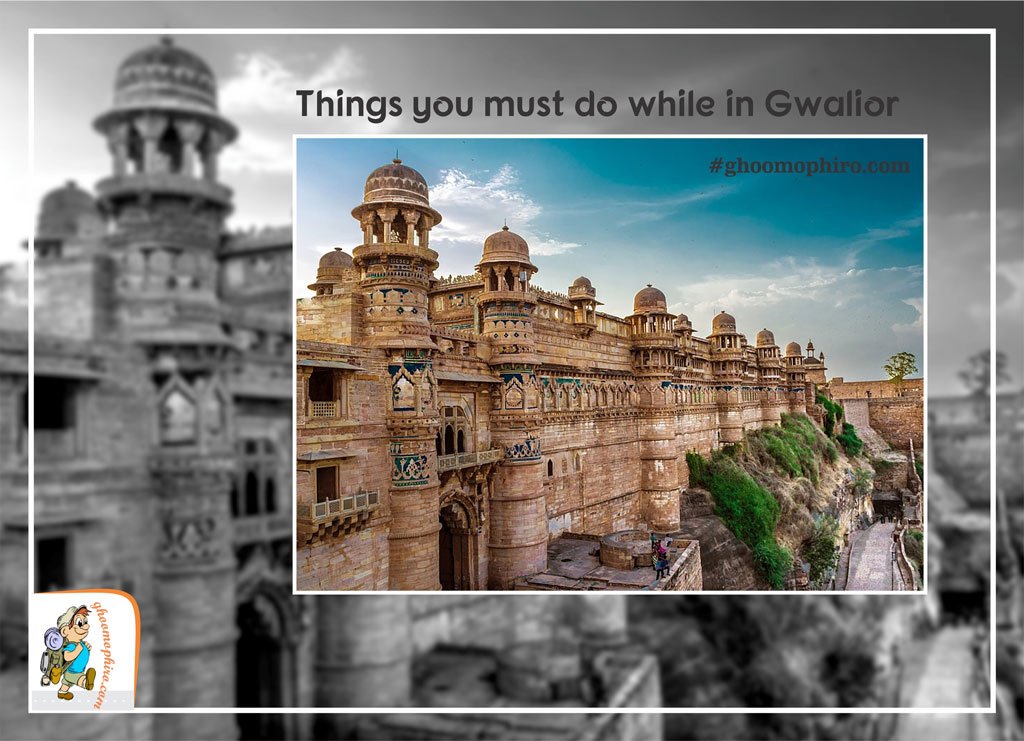
An amazing option for your next getaway if you are a resident of Delhi is Gwalior. This historic city of Madhya Pradesh has stunning forts and temples as well as an art and culture center. Located at a distance of mere 343 kilometers from Delhi it is an ideal weekend getaway and offers enough attractions for an extended weekend as well.
Gwalior itself is packed with attractions that, for the most part, can be visited on a 2 or 3 days getaway but if you can want an extended holiday, you can use it as your camping place for exploring attractions of several nearby towns.
How did we reach Gwalior?
The city has one of the cleanest railway stations you will find in India. Over 50 trains leave for Delhi and Agra. There are somewhat fewer trains for Mumbai though. Its location in the centre of the country ensures its connectivity to most of major cities of the country – Delhi, Mumbai, Kolkatta, Chennai as well as Bhopal, Nagpur as well as central India attractions like Indore, Jhansi, Shivpuri, Jhansi, Bhind, Morena, Dholpur, Etawah, Datia, Jaipur, and Indore.
National Highways connect the city to Delhi, Agra, Mumbai, Shivpuri, Jhansi, etc. Like with railways, Gwalior enjoys good road connectivity to many nearby cities including Bhopal, Indore, Jabalpur, Jhansi, Bhind, Morena, Dholpur, Etawah, Datia, Jaipur, etc.
Gwalior Airport or ‘Rajamata Vijaya Raje Scindia Airport’ is a local airport. It enjoys connectivity to Bombay, Bhopal, Indore, and Delhi
Locally, there are several public transport options – tempos, auto rickshaw taxis, Ola Cabs, and micro-buses.
We chose railways to travel from Delhi to Agra. We could easily reserve seats on a train that was about to leave at about the time we wished to start our journey without much trouble.
What did we eat?
Gwalior’ local cuisine offers a big variety of tastes. Boondi Laddoo, Cheela, Petha, Wale, Poha, dosa, Gajak, etc are some of the locally available food that we personally loved. If you are a prude and do not want to experiment too much, there are of course malls and international food options.
What is the best time to visit Gwalior?
The summers can be too hot and winters can be too cold. In terms of climate, October-November is the best months. We decided to be in Gwalior in time for Tansen Samaroh held in December and found weather pleasant enough (if it wasn’t the effect of classical music 🙂 )
Where to stay?
Gwalior has hospitality options catering to all budgets and you won’t face a problem in finding a hotel suitable for your needs.
Places to see in Gwalior – a 2-day itinerary
Here is what we did in two days.
Day 1 – Gwalior Fort
Gwalior’s biggest tourist attraction is also its most visible landmark – Gwalior Fort. The city was built around the fort and continues to thrive around it. It has unparallel importance in the history of India and has been popularly called “the Gibraltar of India”. The Mughal Emperor Babur famously described it as “the pearl in the necklace of the forts of Hind”.
Built somewhere between 6th and 10th century A.D. Gwalior fort also boosts of second-oldest record of ‘zero’ – in an inscription found in a small temple located on the way to top. This inscription is said to be about 1500 years old.
According to a local legend back in third century A.D., Suraj Sen, a local prince, once lost his way in the forest and ended up meeting an old man, the sage Gwalipa on a secluded hill. He asked the sage for some drinking water and led to a pond, the waters of which not only quenched his thirst but cured him of leprosy. Out of gratitude, the prince asked the sage to ask for something in return. The sage replied by asking him to build a wall on the hill which could protect the other sages from wild animals that so often disturbed their pujas or yajnas. Suraj Sen also built a palace inside the fort, which was named “Gwalior” after the sage, and that also became the name of the city that developed around the fort.

Ever since the fort has been ruled by a number of empires but we won’t bore you with details and will go straight to its several attractions.
Teli Ka Mandir
Teli Ka Mandir (literally Oil Merchant’s temple), a temple built within the fort is an architectural anomaly as instead of being square shaped as is the norm, the temple is rectangular shaped. According to a local legend, the temple was built by oil merchants instead of the royal or priestly class. It has also been claimed to be built by the famous Gurjara-Pratiharas emperor Mihira Bhoja.

To approach the temple, you climb a flight of stairs that lead to this stunning banded doorway containing sculptures of river goddesses Ganga and Yamuna. The waists are shown leaning towards the center, each with a boy and a girl on the lower part. Above them one see works showing amorous couples in different stages of courtship and intimacy (mithuna). There are also male and female dvarapalas along with the outer and inner doorways, each carrying weapons and kind expression of welcome. The doorway leads to the sanctum sanctorum or garbha griha.
The rectangular structure boosts of a tower that rises up to 80 feet. The doorway into the temple is itself 35 feet high and is ornamented with a relief of Garuda (we found it amazing), the vehicle or vahana of Lord Vishnu. Inside the doorway, there is another doorway above which is a Ganesha relief. There is a sculptor of Nandi and lingam inside in the sanctum. Several inscriptions ornament the temple showing a variety of influences.
Jain Temples
The fort boasts of several Jain temples dedicated to Jain Tirthankaras. Urvahi and Gopachal are the most important of them and boosts of hundreds of sculptures of Jain Tirthankaras. A 58 feet tall statue of Rishabhanatha or Adinatha is the tallest in these temples. The temples much like Hindu temples have suffered much damage due to invasions by Muslim rules but are still popular.

Gurdwara Data Bandi Chhor
Another important religious landmark is Gurdwara Data Bandi Chhor. It was built at the place where the 6th Sikh Guru Hargobind Sahib was arrested and held captive at the age of 14 years by the fourth Mughal Emperor Jahangir in 1609 on the pretext that the fine which imposed on his father, the fifth Sikh Guru Arjan had not been paid by the Sikhs and Guru Hargobind. According to the legend, when the fine was paid, the 52 Rajas who were also imprisoned in the fort as hostages for opposing the Mughal empire were dismayed as they were losing a spiritual mentor. Guru Hargobind requested the Rajas too to be freed along with him. Jahangir allowed him to free as many rajas could hold on to the guru while leaving the prison. Guruji got himself a special gown stitched which had 52 hems. As Guru Hargobind was leaving the fort, the captive kings caught the hems of the cloak and left along with him.
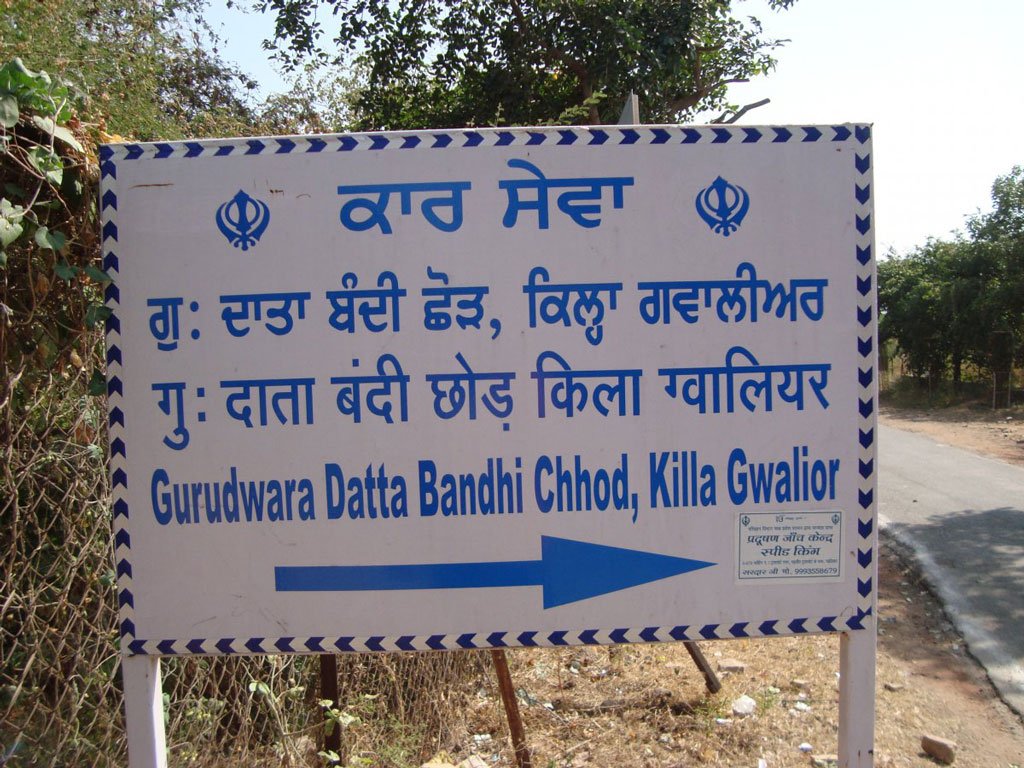
Man Mandir Palace
Gwalior has several palaces but the most important one is Man Mandir Palace which is an architectural wonder. It was built by the King of Tomar Dynasty – Maharaja Man Singh in the 15th century for his favorite queen, Mrignayani. It is often referred to as a Painted Palace as it seems to have been painted due to the use of styled tiles of turquoise, green and yellow used extensively in a geometric pattern. It seemed so different from other palaces of India and we were simply awed by its beauty. This palace hosts a light-and-sound show which is the perfect way to immerse yourself in the historical journey of the city.
Gujari Mahal or Museum
Gujari Mahal was also built by King Tomar, when Mrignayani, demanded a separate fort for herself with its own water supply. The palace is now an archeological museum and holds several artifacts. Karan Mahal and Vikram Mahal are some of the other palaces.
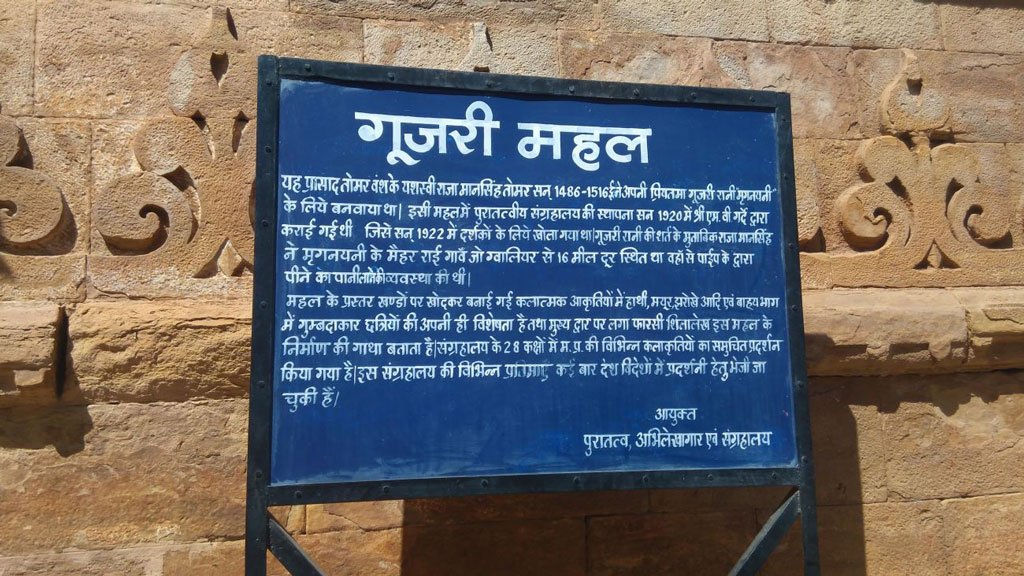
Day 2 – other attractions of Gwalior
Jay Vilas Palace
A palace built to welcome Prince Wales, Jay Vilas Palace is built according to European architecture. This stunningly beautiful palace which might stand in the election for Selfie-capital of the country was built by Maharajadhiraj Shrimant Jayajirao Scindia Alijah Bahadur, the Maharaja of Gwalior in 1874 and still continues to be the residence of his descendants the former royal Maratha Scindia dynasty. Its beauty evades all description and has to been seen.
Built by architect Sir Michael Filose, the interior of the Durbar Hall is decorated with gilt and gold furnishings and adorned with a huge carpet and gigantic chandeliers. According to a legend, eight elephants were suspended from the durbar (royal court) hall ceiling to check it could cope with two 12.5m-high, 3.5-tonne chandeliers with 250 light bulbs, which are the largest pair in the world.
Scindia Museum is an important museum in Gwalior built in 1964, within Jai Vilas Palace in Gwalior. Scindia Museum. It is dedicated to Jivaji Rao Scindia, the last ruling Maharaja of Gwalior from the Scindia dynasty. The highlight of the museum is the glass furniture. Apart from this, the Scindia Museum also exhibits manuscripts, sculptures, coins, paintings, weapons, from that period. The Museum is closed on Wednesdays and is open between 10 a.m. and 5:30 p.m. on other days. There is a nominal ticket fee required.
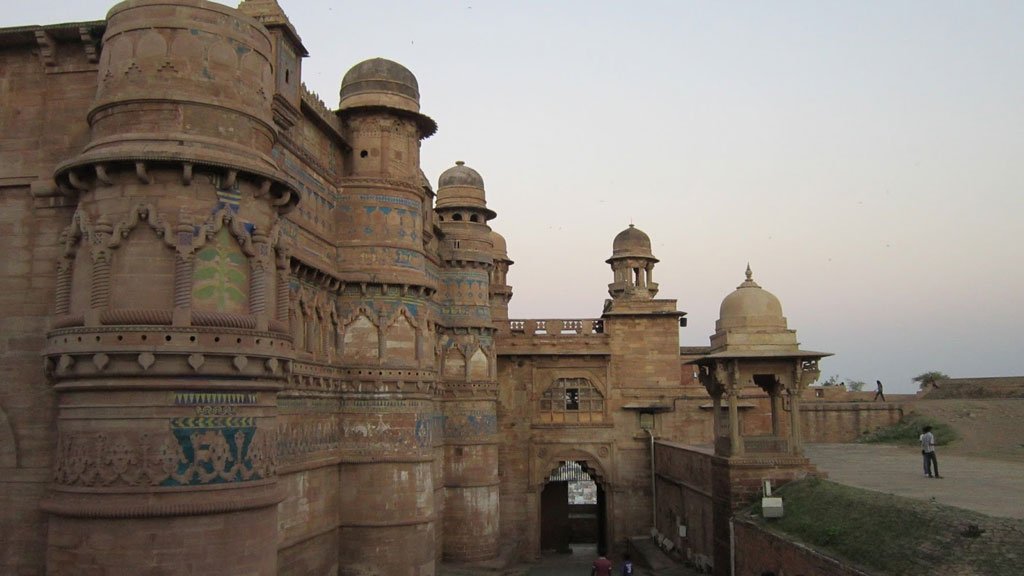
There are many amazing artifacts to be seen here. We particularly loved the idea of a mini silver train, still, in working condition, that would be used to carry salt, pepper, etc on the royal dining table.
Tomb of Ghaus
Ghaus was a sufi saint who assisted Babur in his conquest of the Gwalior Fort and was the mentor of Musical legend Tansen whose tomb is also located in the city. The tomb of Ghaus is a small architectural wonder in its own right.
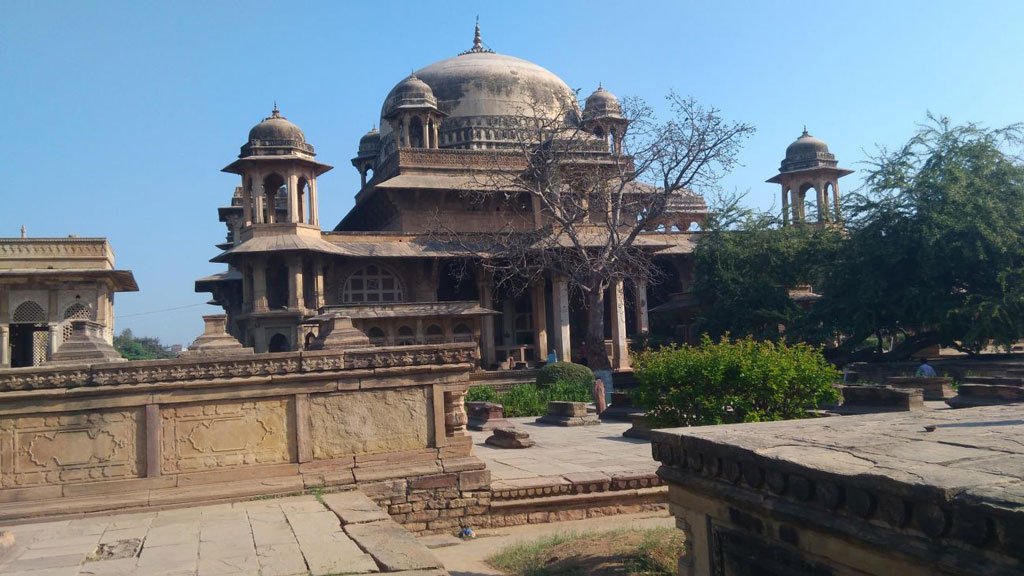
Gwalior Zoo
If you were not satisfied with National Park, Gwalior has its own zoo that was established by the Scindia family back in 1922. It is also known as the Gandhi zoo. It is home to a variety of rare animals like bison, hyena, spotted deer (which were adorable, a white tiger, sambhars, crocodiles, monkeys, some birds, etc. The zoo also features a Phool Bagh here which was inaugurated by the Prince of Wales.
Vivaswan Surya Mandir
Built by G.D. Birla, Vivaswan Surya Mandir is a sun temple which tries to replicate Konark sun temple in all its splendor – surrounded by a lush garden, having sandstone exterior and marble interior, it is one of most fascinating attractions of fort-city. The temple is opened between 6:30 am to 12:00 pm and 1:00 pm to 6:00 pm.
8. Suraj Kund
The Suraj Kund or ‘the lake of the Sun’ was built around the 10th century by King Surya Pal, a devotee of Sun god. The compound is located outside the Gwalior fort and also has a lush garden and another pool called ‘Siddha kind’.
9. Tansen Tomb
Like we mentioned earlier, Gwalior is a major art and culture center. The musical genius Tansen’s tomb is located here. It is a piece of architectural wonder and the place is also home to several other tombs. His tomb is near a tarmarind. According to a legend, Tansen chewed on the leaves of a tamarind tree and he proclaimed it to be the secret of his spectacular voice. Tansen died in Delhi but was brought here to find his final resting place near his mentor Mohammed Ghaus. The tomb of Tansen is a relatively small one and would be easy to miss if it were not for the board proclaiming it.

The Tansen Tomb is the place where Tansen Samaroh is held in December every year in form of musical extravaganza in which famous musicians from all over the world pay tribute to the great musical legend of the country.
A five-day itinerary – including nearby attractions for an extended Getaway
Gwalior itself might be seen in 2 days according to above place but if you have more time at your proposal, the way we did, you can consider spending 3 more days in Gwalior to make trips to nearby towns of tourist attraction. In that case, you might consider the following:
Day 3 – Padavali And Bateshwar
An ancient fortress located at a distance of about 40 kilometers from Gwalior city center, Pandava is perhaps most notorious for its erotic cravings which have won it a reputation as a sort of mini-Khajuraho. The fortress boosts of over 200 sandstone temples.

Day 4 – Mahadev National Park
Looking for a break of so much of history and culture, we decided to spend some time in Mahadev National Park. The park is home to several animals – blackbuck, nilgai, leopard and chinkara as well as some of the migratory and domestic birds like heron, kingfisher and more. The national park is opened from 6:30 am to 10:00 am and 2:30 pm to 6:00 pm and can be visited in 3 to 5 hours. The National Park is located in Shivpuri at a distance of 112 kilometers.
Day 5 – Orchha
Having served as a capital of Bundela Rajput, Orchha is home to several temples and palaces showing Bundela architectural genius. The town is located at a distance of 120 kilometers from Gwalior but has several attractions including a Wildlife Sanctuary.
Conclusion
It is amazing how Gwalior has not yet started attracting as many tourists as its attractions should suggest but that will make it all more attractive to those tourists who want to avoid too crowded cities. There is a caveat though that must be mentioned here. Gwalior is one of the most polluted city not only of India but of the world and so fresh air is not one of the perks it has to offer. It is a problem that the local government is trying to counter. That said it is one of the must-visit tourist attractions of central India in particular and India in General. Its temples, palaces, forts – and not to mention the train artifact is not easy to ignore. Cheers. J




